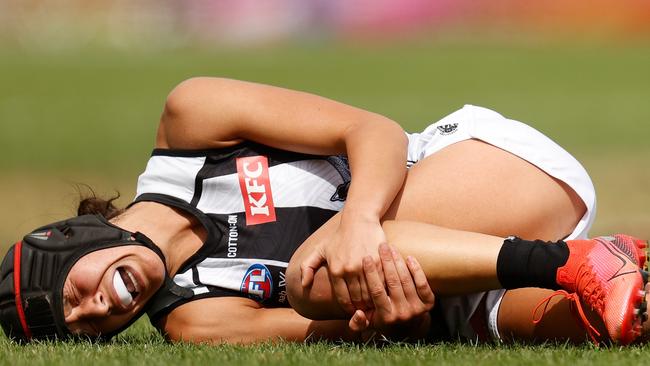‘Willing to share our learnings’, Rugby 7s ready to take rival codes’ call
Rugby 7s once had a similar problem with ACL injuries that the AFLW and NRLW are currently facing but were able to quickly turn things around. And they’re willing to share what they know.

AFLW
Don't miss out on the headlines from AFLW. Followed categories will be added to My News.
Three letters no athlete ever wants to hear.
ACL.
Anterior cruciate ligament and on average, they require 12 months of rehabilitation.
But they are also the three letters more and more teenage girls - and their parents - are hearing.
The most extensive analysis of knee injuries in Australia has revealed the stunning revelation that the sharpest rise for ACL injuries are girls aged 5-14 years.
Doctor Nirav Maniar, who studied 228,344 knee injuries over a 20-year-period, said one possible explanation for this trend could be increasing female participation in “high risk” sporting activities over the analysis period.
“We have seen more young girls participating in high-risk sporting activities which likely explains the high injury rates we are seeing in this age group,” Dr Maniar said.
“By high-risk we mean sports requiring frequent changes of direction and landing - sports such as Australian rules, rugby union and league, all the football codes, netball etc.
“There are more pathways for girls at the grassroots and elite level to take part in sport which is a wonderful thing but such a steep rise in annual knee injuries in children is concerning.”
The study also found data from Victoria supported the hypothesis, showing female sports participation has increased from 2011 to 2016.

Specifically, females aged 5−9 years had doubled participation rates in 2016 compared to 2011.
These figures were further supported by research from VicHealth and Sport and Recreation Victoria who compared 2015 with 2019 and found overall participation numbers
increased by 119,229 to a total of 868,266 participants in 2019.
And for females, the largest growth was for 4-year-olds (7%), followed by 5–9 year-olds (5%), and 10–14 year-olds (4%).
Earlier this year, renowned sports medico Dr Peter Larkins said ACL injuries were an ongoing issue for women, particularly for AFLW players.
“When I gave a talk last year, I talked about how the knee ACL surge was happening in women’s sport, and women have a five or six times higher incidence of knee ACL’s than men,” he said.
“Except in the AFL, where it has been 10 times higher since 2016.”
Gold medal-winning Olympic Rugby Sevens coach Tim Walsh said his code had struggled with ACL injuries when the code went from amateur to professional in 2014.
“At the start we had a lot of injuries but we learned from that and learned quickly ... after our success at the Rio Olympics we sat back and watched the AFL and then the NRL escalate their plans for their respective women’s games,” Walsh said.
“And we knew what was going to happen.
“That they would be smashed with ACL injuries but no one came to us and asked how we had mitigated the injuries.
“We were willing, and still are willing, to share our learnings.
“Knee injuries are part of the game but we have also learnt how to train and prepare our players to cut down the risks significantly.”
Doctor Maniar said the alarming trend needed urgent and immediate intervention from the sporting community.
The research, published this month in leading medical journal The Lancet, showed greater annual growth rates for females compared to males for total knee injuries.

Dr Maniar said implementing programs to prevent ACL injuries was critical to improving long-term health outcomes - and all that was needed was a proper warm-up.
The lead author, from Australian Catholic University’s Sports Performance, Recovery, Injury and New Technologies (SPRINT) Research Centre, added that limiting the cost of knee injuries was a public health priority.
He said injury prevention programs can reduce the incidence of ACL injuries by 53 per cent and knee injuries by 37 per cent.
“Research has shown that a woman who has had an ACL injury can be up to six times more likely to develop osteoarthritis,” Dr Maniar said.
“What I would love to see is any policy encouraging physical activity - which is wonderful for health - to include prevention techniques,” he said.
“But there needs to be a greater understanding that we can stop these injuries happening.
“Left unaddressed, the trends suggest the burden of knee injuries is projected to increase,
especially for females.
“Based on our estimations, the annual number of ACL injuries is expected to more than double by 2030−2031 compared to 2017−2018 levels, and cost almost $315 million.
“Additionally, these programs are relatively simple to implement and can be incorporated as part of the general warm up routine.
“Any program encouraging physical activity is a great thing - what I would love to see is for these programs to also embed injury prevention strategies.”


